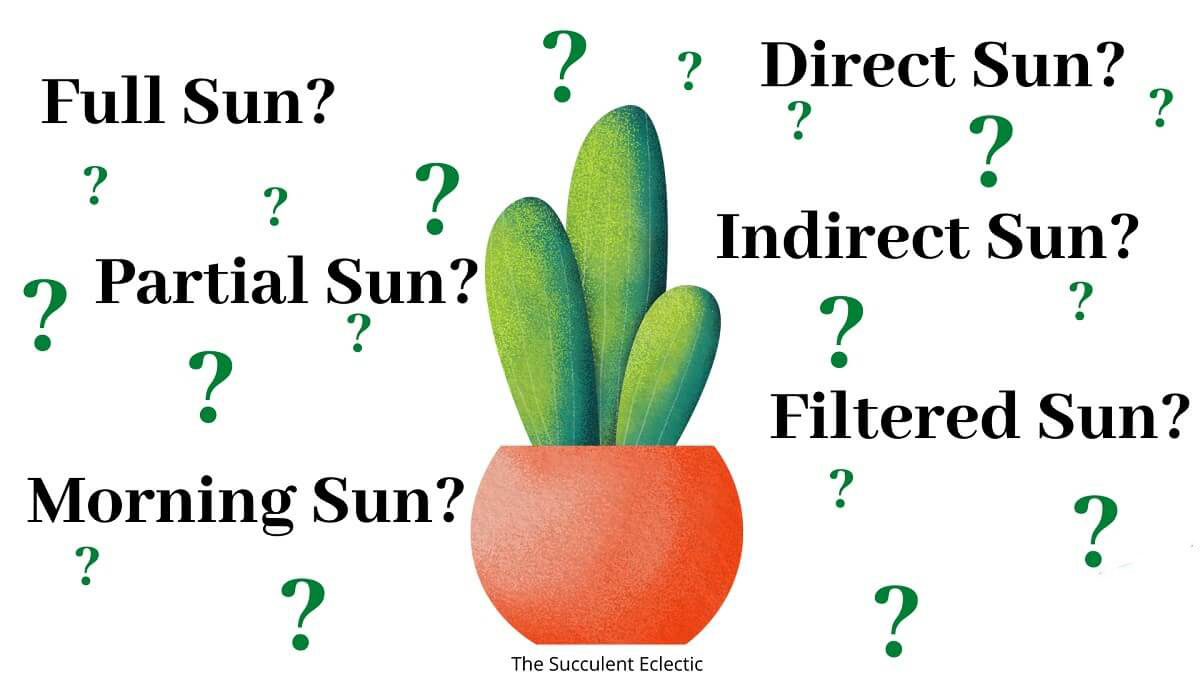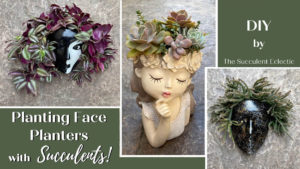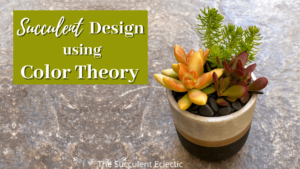The vast majority of the planet’s surface is covered with an extraordinary diversity of plant life. From mountain tops to the shadowed depths of valleys, across deserts, in jungles, and wide plains, plants have evolved to thrive in an enormous range of conditions. Some are exposed to blazing sun all day long. Others thrive in fog-shrouded locations along the coast or at the foot of crashing waterfalls, where sunlight is diffused by the ever-present mist. Others grow in the shade of tall trees, boulders, or other plants. Some plants thrive in the sunlight that filters through a high canopy of leaves. As gardeners, our job is to mimic the native habitat conditions for our plants, right? So how to navigate plant care information that just says “full sun,” or “direct sun,” or “partial shade”? And what is “filtered light,” or “indirect sunlight,” or “partial shade”? Are these the same things? Together, let’s examine what is meant by these sun exposure terms for plants in general and succulents in particular.
Explaining Sun Exposure Terms + Infographic
In this Post We'll Cover:
{Please note, some links in this post may be affiliate links to sites that pay me a small commission if you click on the link and make a purchase. This commission is at absolutely no cost to you. I only recommend products and companies that I have worked with and truly love! ~Kat}
All plants need sunshine, but they cannot all handle the same amount of sun. But determining how much light a specific plant needs involves a number of variables. If sun exposure terms for plants like full sun or indirect sunlight are confusing you, you are not alone! Just imagine trying to reduce the myriad types of lighting to be found throughout the world to a label of just a couple of words. By definition, these lighting terms are imprecise, but overall, they do a good job guiding gardeners in providing the right lighting for their plants. Let’s see what is meant by these sun exposure terms:
- Direct Sun – the plant is outdoors in the direct path of the sun
- Full Sun – the plant needs direct sun for at least 6 hours on a daily basis
- Partial Sun – the plant is outdoors, in direct sun for 3-6 hours per day
- Filtered Light – indoors or out, the sun’s rays must pass through clouds, trees, or curtains before reaching the plant
- Indirect Sunlight – indoors or out, the sun’s rays first reflect off another object before reaching the plant
- Bright Indoor Light – the plant is indoors, receiving abundant natural light through glass windows or from artificial fixtures
Often, plants are described as needing a range of light conditions, like full sun to partial sun or indirect sunlight to bright indoor light. Always provide as much light as you can within the sun exposure range for the plant’s health.
What is Direct Sun
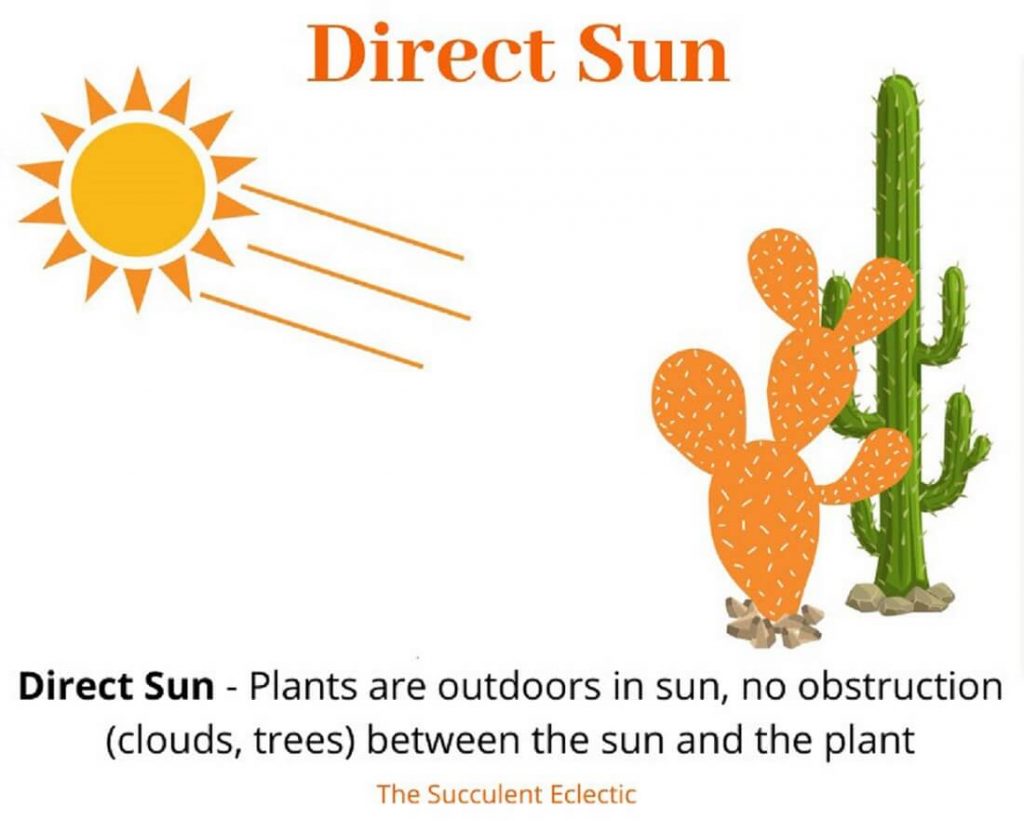
Sun exposure terms like full sun and indirect sunlight are defined using two critical elements: time, meaning the daily duration of the plant’s exposure to the sun, and the path the light travels from the sun to reach your plant. Every sun exposure term relating to plants relies on one or the other, and often both time and the path light travels.
Direct sun means the plant is outdoors in the direct path of the sun. Light travels from the sun to hit your plant directly with no obstructions between them. Even when sunlight shines right through clear glass, the intensity is dramatically reduced, and this is not considered direct sun. There are no trees, mountains, boulders, or even cloudbanks to deflect the sun’s rays away from your plant. The shadow cast by your plant will be dark with crisp, clear outlines when the plant is in direct sun.
Because there is no time period as part of the definition, it isn’t useful to list the plants that grow in direct sun. Most plants can handle a short period of direct sun, and in the morning or late afternoon, direct sun is much less intense than in the middle of the day.
What is Full Sun
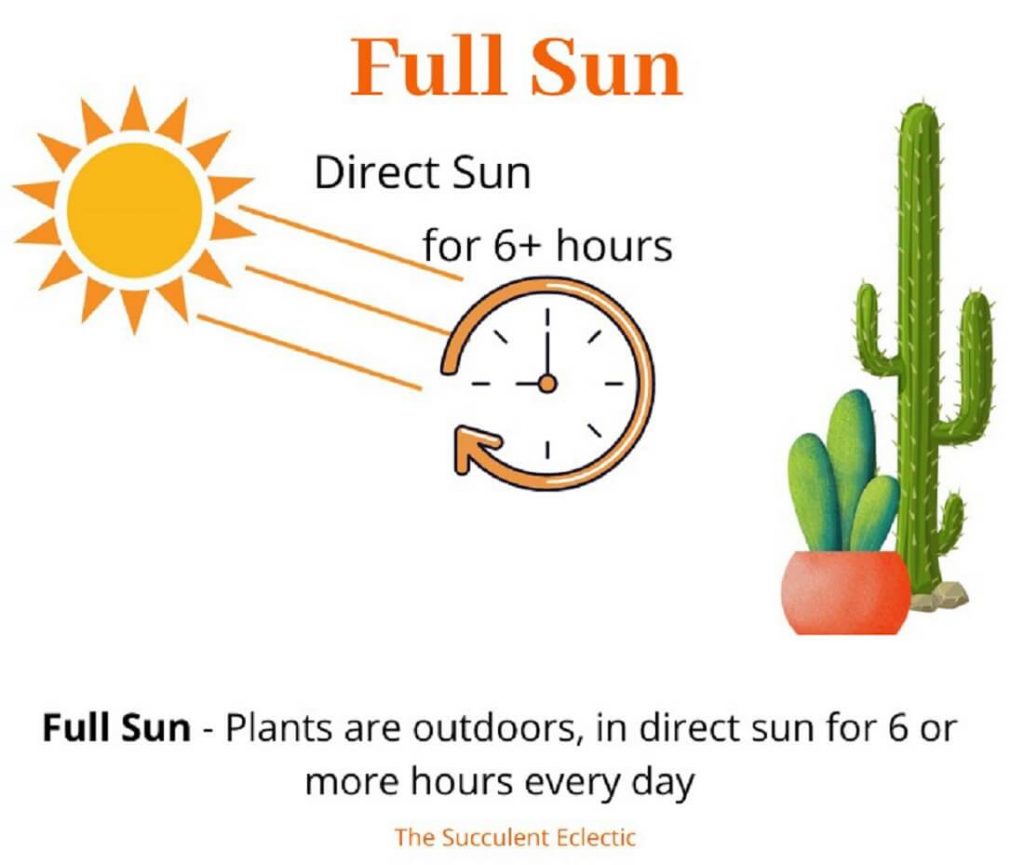
Direct sun means the plant is in the direct path the light travels from the sun to the plant. The term “full sun” adds a time element. A full-sun plant needs direct sun for at least 6 hours on a daily basis. It’s important to recognize that “full sun” in the midst of a brutally hot summer is much more intense than full sun in a moderate spring or fall. So stay aware of your specific climate conditions when you provide full sun for your plants.
Full sun plants are typically native to wide-open areas like plains or broad deserts, where they are unshaded by trees, boulders, or other larger plants. Saguaro cactus, most Agave, some Aloe, many Echeveria, most Euphorbia, most Graptopetalum and hybrids, Kalanchoe lucaiae “Flapjacks” or “Paddle Plant”, Opuntia, some hardy Sedum and Senecio serpens ‘Blue Chalksticks’ are examples of succulents that thrive in full sun.
Be aware that some varieties, like Aeonium and Sempervivum, thrive in full sun but cannot take the heat of high summer. They may go dormant in the summer sun yet remain actively growing in a shady spot. Also, understand that succulents and other plant varieties that can take full sun must acclimate to it gradually, or they will risk sunburn.
Partial Sun
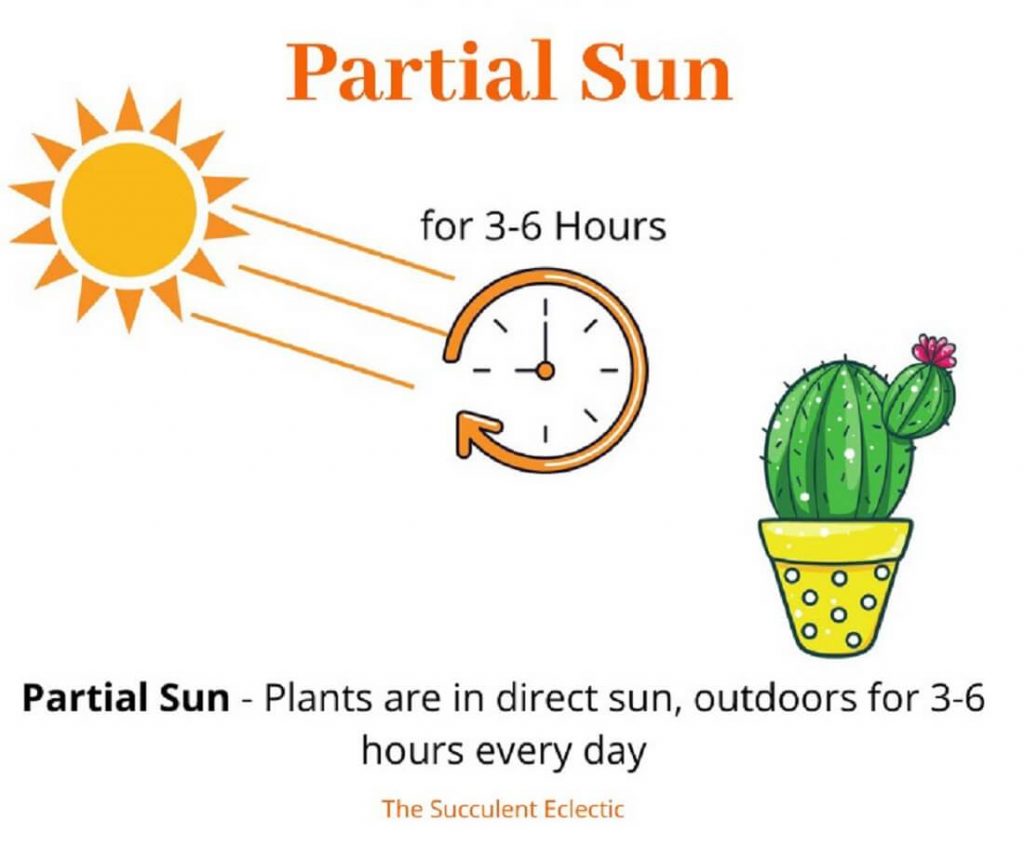
The terms “partial sun” and “partial shade” are closely related and sometimes (mis)used interchangeably. Partial sun is when the plant is outdoors, in direct sun, for 3-6 hours per day. Partial shade is when the plant is outdoors, in direct sun for 3-6 hours per day, but specifically needs protection during the heat of mid-day.
Partial sun and partial shade plants are native to conditions where hillsides, tall trees, boulders, and larger plants provide shade during part of the day while allowing direct sun to fall on the plant for several hours. Plants growing on the floor of a canyon may see direct sun for just a few hours, resulting in partial sun. You may have partial sun conditions in your garden under trees, under bushes, or in the shade cast by the neighbor’s house.
Many Aloe, most Crassula, most Cotyledon, some Echeveria, Fenestraria, all Portulacaria, and most Senecio thrive in partial sun. You’ll often find that the variegated versions of full-sun succulents appreciate the protection of partial sun. The pigment-free portions of their leaves tend to burn more easily.
Filtered Light
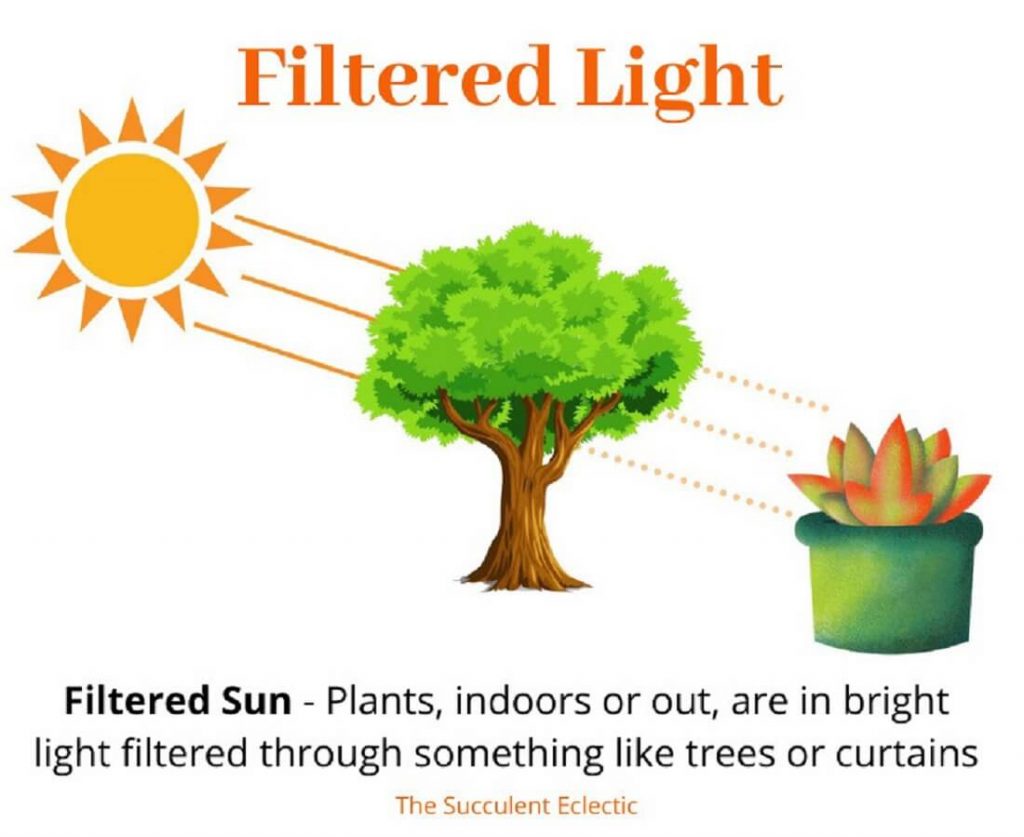
With filtered sun, the sun’s rays must pass through an imperfect obstruction before hitting your plant. The light is “filtered” through a cloud bank or the leafy canopy of tall trees. Plants that thrive in filtered sun are native to conditions where they grow along a foggy coastline or in the dappled shade at the base of tall, leafy trees. You may find filtered sun in your garden under trees or in the shade of much taller shrubs or even other succulents like Euphorbia tirucalli ‘Sticks on Fire’ or Portulacaria afra. If you have large, sunny windows with semi-sheer curtains, the light streaming through them will give indoor plants filtered light. The shadow cast by your plant will be far less distinct in the filtered sun than in direct sun. The edges of the shadow will be blurry.
Succulents that thrive in filtered light tend to be those that will do best for you indoors. Look for Faucaria, Gasteria, Haworthia, Kalanchoe blossfeldiana, Sansevieria and Schlumbergera as good examples of succulents that grow well in filtered light.
Using shade cloth to create filtered light in otherwise full sun conditions is a great way to provide lighting that will enable nearly all succulents to thrive. Commercial succulent growers stretch shade cloth over thousands of plants, providing bright light without the risk of sunburn all day long.
Indirect Sunlight
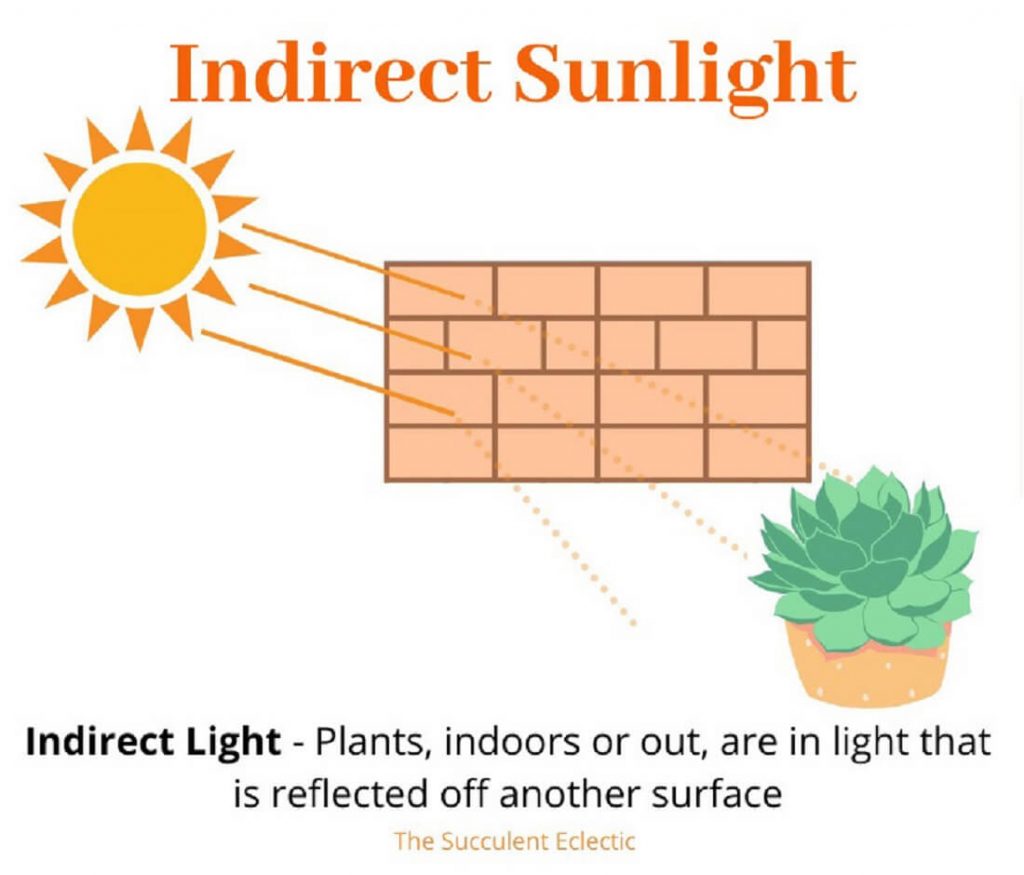
Indirect light is when the sun’s rays first bounce or reflect off another object before reaching the plant. Just as much of a thrown ball’s energy is absorbed by the wall it bounces off before it comes back to you, the sun’s rays lose a lot of intensity when they first reflect off another surface before reaching your plant.
Plants that thrive in indirect light are often found growing in rocky locations that are filled with boulders. Where you see many white or light-colored boulders and rocks, you’ll find plants growing in the shade cast by large stones, enjoying the indirect light reflected from others. White stucco walls, flagstone, concrete, and ponds are sources of indirect light in your garden. The shadow cast by your plant in indirect sun will be fainter than in direct sun, with slightly fuzzier edges.
Typically, plants that are happy in filtered light will also do well in indirect light.
Bright Indoor Light
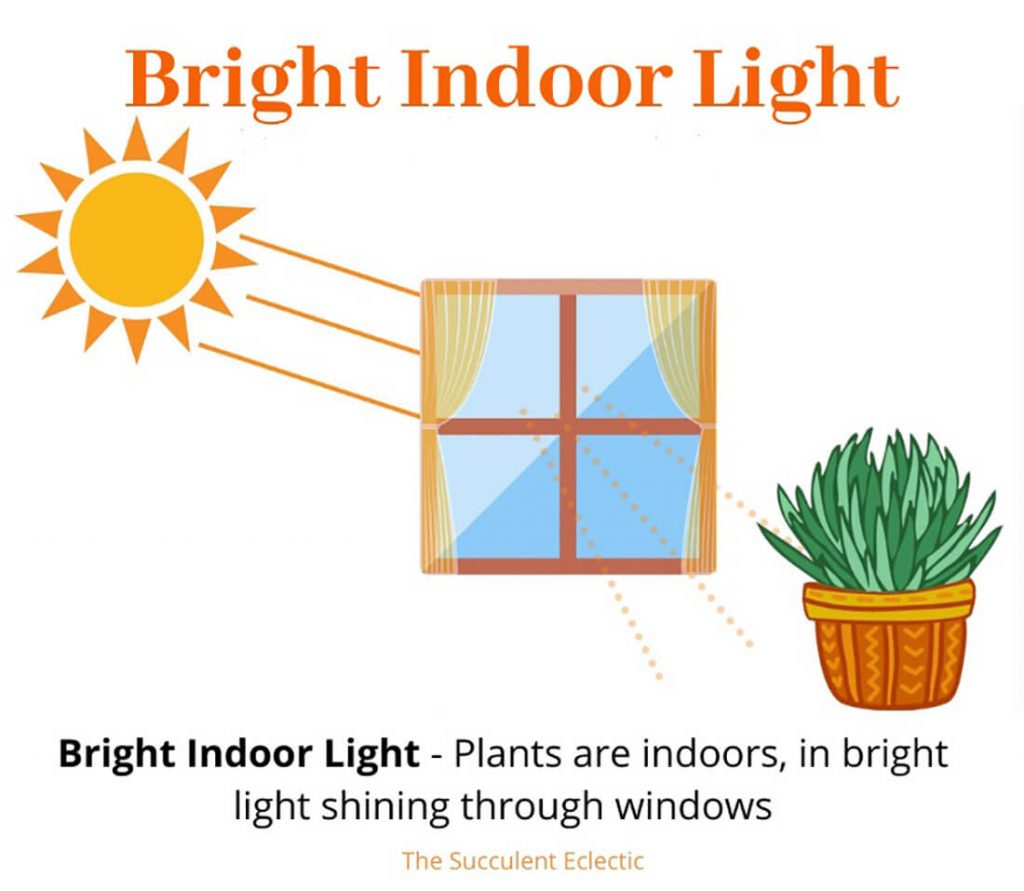
Bright indoor light is found where sunlight streams through glass windows or skylights, filling the room with natural light. If you’re not blessed with such a home, you can boost the natural light with artificial lighting, both from regular fixtures as well as grow lights for plants. Bright indoor light casts light-colored shadows with blurry edges.
While no plants have evolved over millennia to thrive in bright, indoor light, obviously, there are many that grow in filtered light and indirect light that will thrive indoors. Further, hybridizers are always working to develop more varieties that will flourish indoors. For the best succulents to grow in bright, indoor light, look for many Aloe, many Crassula, Cotyledon, Gasteria, Haworthia, some Kalanchoe, Oscularia, Peperomia, some tender Sedum, some Senecio and Tillandsia (air plants, not true succulents).
Remember, these sun exposure terms are an imprecise guide developed to help you to care for your plants. Julie Kaye Dehne, a member of my Facebook group for succulent-lovers, asked me for this post, explaining the various sun exposure terms as they apply to succulents. Thanks for the suggestion, Julie! Whether succulents are your first love, you’re growing houseplants or you are gardening with a wide range of plants, I hope you found this helpful! If you have any questions or feedback, please take a moment to leave me a comment, and I’ll get right back to you!
Feel free to download the infographic below!

P.S. – For more succulent care information, please subscribe! I’ll send you my FREE e-course 7 Steps to Succulent Success! – Thanks so much!
P.P.S. Why not join my Facebook Group for succulent lovers? We talk about succulent care, propagation, succulent identification, and design. It’s a warm and welcoming group that would love to meet you!
<– Click the Lighting Terms for Succulents infographic, then click on magnifying glass icon for the best view.
Then, return to this page! 🙂
